Origins of a New Monitoring Project
Since 2005, the Estuary Program has monitored our local eelgrass beds through field surveys. A small component of the work involves tracking changes in macroalgae, often referred to as “seaweed.” In 2020 and 2021, our surveys picked up a noticeable increase in macroalgae across the estuary, particularly the genus Ulva or “sea lettuce.” Ulva is not new to the estuary, but the thick mats seen lying on top of eelgrass beds raised concerns that it could smother the recently recovered eelgrass. We want to better understand the fluctuations of algae abundance and its potential impact on eelgrass. To achieve this goal, we developed a new monitoring effort which kicked off in May.
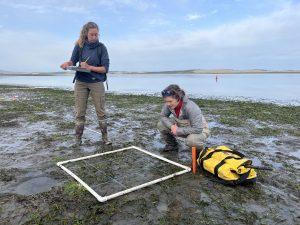
What Makes Algae Different from Eelgrass?
Before digging into the details of the macroalgae monitoring, let’s take a brief look at the similarities and differences between macroalgae and eelgrass. Both use photosynthesis to convert sunlight into chemical energy and require the uptake of nutrients to survive. Both provide numerous benefits to the ecosystem, such as shelter, food for various estuary-dwellers, and carbon sequestration.
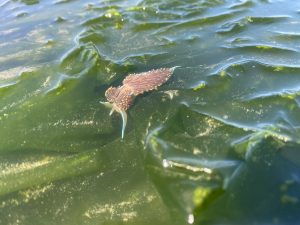
Eelgrass (Zostera marina) is a flowering plant found in intertidal and subtidal areas along the coast and shares many of the same characteristics as plants on land. Eelgrass blades sprout from roots called rhizomes that create a tangled network just below the sand and mud. The plant can also propagate through the release and transport of seeds. Algae, on the other hand, do not have flowers. Depending on the type of algae, they often reproduce through fragmentation or the release of spores.
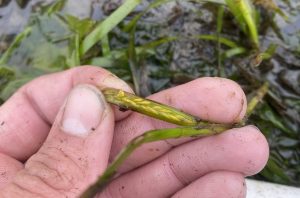
Eelgrass is similar in many ways to the grasses found on land. It utilizes a system of roots and veins to absorb, store, and transport nutrients and water throughout the rest of the plant. Algae, on the other hand, utilize an anchoring structure called a holdfast instead of roots or rhizomes. Some algae can even survive by drifting along in the water, no tether to the ocean floor required! They obtain nutrients through diffusion with the surrounding water, without the use of specialized tissues like eelgrass.
What Are the Implications of These Differences?
One of the primary differences between algae and eelgrass is the relative simplicity of algae’s nutrient uptake and reproduction strategies. This allows it to respond quickly to increased nutrients and grow rapidly. For this reason, algae blooms are considered an indicator of eutrophication, or the presence of excess nutrients.
Abundant algae have the potential to either help or hurt eelgrass, as they have a complex relationship with each other. Thick mats of algae can prevent light from reaching the eelgrass, decreasing its ability to photosynthesize and grow. However, algae can also provide a benefit to eelgrass by preventing it from drying out during low tides. By initiating a project focused solely on macroalgae, we aim to learn more about the connectivity between algae and eelgrass health.
Monitoring Algae Within the Estuary
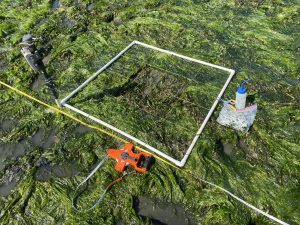
The macroalgae monitoring project was designed to be similar to our eelgrass monitoring projects. These projects utilize a system of transects along which quadrats are spaced at regular intervals. Quadrats are one-meter by one-meter squares made of PVC pipe. Percent cover of algae is then assessed in this square meter. Using quadrats helps break up a study site into smaller, more workable pieces. Conditions in the surrounding area can then be estimated from these small pieces.
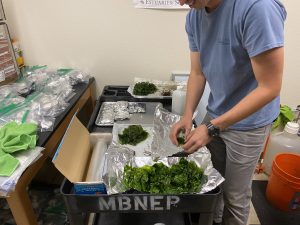
After finishing the survey, algae samples are brought to a lab on the Cuesta College campus where they are dried in an oven. Drying is a critical step since much of its weight comes from water.
What We’ve Discovered So Far
Our preliminary results indicate that Ulva is more abundant near the mouth of the bay. This may be due to the influx of nutrients during upwelling. This phenomenon, common in the springtime, occurs when wind drives surface waters offshore and circulates nutrient-rich water from deeper depths to the surface. The effects of upwelling are felt most strongly near the bay mouth, where the upwelled waters are brought in during high tides.
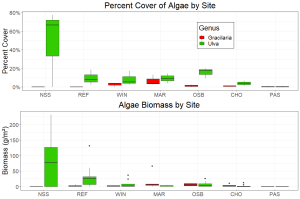
Other types of algae, such as the red and stringy Gracilaria, are found at the highest concentrations in the middle of the bay. These differences in distribution are likely due to differences in preferred water temperatures. Ulva thrives in cold conditions, while Gracilaria prefers the warmer water of the midbay.
Further analysis is currently underway to better understand other connections between algae and eelgrass. These topics include the elevation at which different types of algae thrive, and how eelgrass abundance correlates with algae abundance. Eelgrass health condition data collected during surveys in June will help associate algae abundance with eelgrass health at a more detailed level. In the long term, further rounds of macroalgae monitoring will track differences between seasons and years, offering a much clearer view of the algae-eelgrass interaction.
Help us protect and restore the Morro Bay estuary!
- Donate to the Estuary Program today and support our work in the field, the lab, and beyond.
The Estuary Program is a 501(c)3 nonprofit. We depend on funding from grants and generous donors to continue our work. - Support us by purchasing estuary-themed gear from ESTERO. This locally owned and operated company donates 20% of proceeds from its Estuary clothing line and 100% of Estuary decal proceeds to the Estuary Program. Thank you, ESTERO!
- Purchase items from the Estuary Program’s store on Zazzle. Zazzle prints and ships your items, and the Estuary Program receives 10% of the proceeds. Choose from mugs, hats, t-shirts, and even fanny packs (they’re back!) with our fun Estuary Octopus design, our classic Estuary Program logo, or our Mutts for the Bay logo.
Thank you for helping our beautiful, bountiful, biodiverse bay!